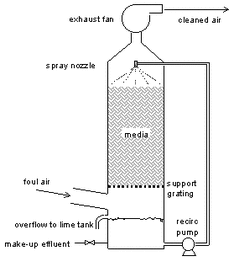 Source: Cheresources.com
Source: Cheresources.com In all cases, biofilters rely on the ability of microbes to covert odors and hazardous compounds into less problematic forms.
The most discussed conversion by Thiobacillus sp, Thiosphera, & Paracoccus sp. Is the following:
H2S + 2 O2 --> H2SO4
The microbes also have the ability to neutralize odors from other organic sulfur compounds including mercaptans. In the case of Thiosphaera and Paracoccus sp, the microbes can also utilize volatile organic acids such as acetic, butyric and propionic acids.
While we often focus on the engineering aspects including residence time and specific filter media, the microbes are often considered as ubiquitous and should be present at all times. In my experience, the population makeup and concentrations vary significantly based on pH, temperature, and inlet gas makeup. There are seasonal and site specific variations that can cause problems maintaining maximum removal efficiency.
First the general design parameters are (from Metcalf & Eddy Wastewater Engineering):
Moisture 50 - 65%
Temperature 15 - 35oC
pH 6 - 8
Res. Time 30 - 60 seconds
H2S Removal 80 - 130 g/m3 per hour
Other Odor 20 - 100 g/m3 per hour
In operating the filters, the moisture is maintained with a spray/pump system. The water contains added nutrients (N &P) and alkalinity supplements to maintain the biomass in ideal conditions.
Treatment issues can occur with low removal efficiency at startup, increased loadings (summer temperatures), during seasonal temperature changes at the filter itself. While the biomass will eventually adjust and reach a steady-state, the time lag can cause issues for operators.
To reduce the time lag and help with periodic losses in efficiency, I propose the owners of trickling filters evaluate adding sulfur oxidizing cultures directly to their biofilters. Over the past decade, I have worked with multiple strains of Thiobacillus, Thiosphaera, and Paracoccus for use in sulfide containing wastewater streams. All are well adapted for growth in biofilters and can help increase the population of active microbes without the normal lag time seen as indigenous microbes grow.

 RSS Feed
RSS Feed